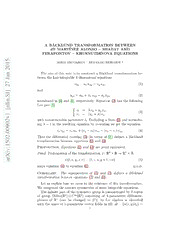
A B\"acklund transformation between 4D Mart\'{\i}nez Alonso -- Shabat and Ferapontov -- Khusnutdinova equations PDF
Preview A B\"acklund transformation between 4D Mart\'{\i}nez Alonso -- Shabat and Ferapontov -- Khusnutdinova equations
A BA¨CKLUND TRANSFORMATION BETWEEN 4D MART´INEZ ALONSO – SHABAT AND FERAPONTOV – KHUSNUTDINOVA EQUATIONS 5 1 BORIS KRUGLIKOV † AND OLEG MOROZOV ‡ 0 2 n The aim of this note is to construct a B¨acklund transformation be- a tween the Lax-integrable 4-dimensional equations J 7 u = u u −u u (1) 2 ty z xy y xz and ] I S u = u +u u −u u (2) yz tx x xy y xx . n introduced in [4] and [1], respectively. Equation (2) has the following i l Lax pair [1]: n [ v = λv +u v , t y y x (3) 1 (cid:26) vz = (ux +λ)vx. v 2 with non-removable parameter λ. Excluding u from (3) and normaliz- 0 ing λ = 1 in the resulting equation by re-scaling we get the equation 9 0 v v = v v +(v −v )v −(v −v )v . (4) 0 x yz x tx y t xx x z xy . 2 Thus the differential covering (3) (in terms of [2]) defines a B¨acklund 0 transformation between equations (2) and (4). 5 1 : Proposition. Equations (1) and (4) are point equivalent. v Xi Proof. Prolongation of the transformation ψ: R4 ×R → R4 ×R r a ψ(t,x,y,z,v) = (t,z,u,y +t,−x) (5) maps equation (4) to equation (1). q.e.d. Corollary. The superposition of (5) and (3) defines a B¨acklund transformation between equations (1) and (2). Let us explain how we came to the existence of this transformation. We computed the contact symmetries of some integrable equations. The infinite part of the symmetry group is parametrized by 3 copies of group Diffeo(R1)⊗ˆ C∞(R1) consisting of 1-parametric diffeomor- phisms of R1 (can be changed to S1); its Lie algebra is identified with the space of 1-parametric vector fields in 1D: Q = {a(x,y)∂ } ≃ x 1 2 BORIS KRUGLIKOV& OLEG MOROZOV C∞(R2) (here R2 = TR1 can be changed to TS1 = S1 ×R1) with the Lie bracket [a(x,y),b(x,y)] = ab −a b. x x Everywhere below a ≃ Q will be the graded pieces of the infinite part i s∞ of the symmetry algebra g. The upper index indicates the different commuting copies of the graded subalgebras, i.e. [gα,gβ] ⊂ δαβgα . i j i+j The symmetry algebra of equation (1) is the semi-direct product g = s⋄ ⋉s∞, where (ai ≃ Q) s∞ = (a′0 ⊕a′1)⊕a′0′; s⋄ = (R1 ⋉R1)⊕(R1 ⋉R1). Similarly, the symmetry algebra of equation (2) is the semi-direct product g = s⋄ ⋉s∞, where s∞ = a0 ⊕a1 ⊕a2; s⋄ = sl2 ⋉(R2 ⋊R1). The modified (Ba¨cklund equivalent) version of equation (1) is the following equation, [5], (we again normalize λ = 1 by re-scaling) u u = (u +u )u −u u . (6) x ty t z xy y xz Its symmetry algebra is the semi-direct product g = s⋄ ⋉s∞, where s∞ = a′0 ⊕a′0′ ⊕a′0′′; s⋄ = (R2 ⋊R1); The equations (1), (2), (6) have different symmetry algebras. But equation(4), which is a modified version of (2), has thesame symmetry as (1). Although coincidence of symmetry algebras is only a necessary condition for equivalence of two equations, in this case we obtain the equivalence defined by (5). Remark. In [3] we constructed symmetric integrable deformations of some heavenly type equations. These also exist for the equations (1), (2), (4) and (6) considered in this paper. For the first of them we have such an integrable deformation: u −u u +u u +(Qu ) = 0, Q = Q(t,y,z). ty z xy y xz y y This equation has a covering defined by system w = λu w , y y x (cid:26) wz = λ ((uz −λQuy)wx −wt). The functional parameter Q is (essentially) non-removable. Details of this construction andinformation onother integrable deformations will appear in a forthcoming paper. BA¨CKLUND TRANSFORMATION BETWEEN TWO 4D EQUATIONS 3 References [1] E.V. Ferapontov, K.R. Khusnutdinova, Hydrodynamic reductions of multi- dimensional dispersionless PDEs: the test for integrability, Journal of Mathe- matical Physics 45 (6), 2365-2377(2004). [2] I.S. Krasil’shchik, A.M. Vinogradov, Nonlocal symmetries and the theory of coverings, Acta Appl. Math. 2, 79–86 (1984). [3] B. Kruglikov,O.Morozov,Integrable dispersionless PDE in 4D, their symme- try pseudogroups and deformations, arXiv:1410.7104(2014). [4] L. Mart´ınez Alonso, A.B. Shabat, Hydrodynamic reductions and solutions of a universal hierarchy, Theoret. Math. Phys. 104, 1073–1085(2004). [5] O.I. Morozov, A. Sergyeyev, The four-dimensional Mart´ınez Alonso–Shabat equation: Reductions and nonlocal symmetries, Journal of Geometry and Physics 85 40–45 (2014) † Institute of Mathematics and Statistics, NT-Faculty, University of Tromsø, Tromsø 90-37, Norway. E-mail: [email protected] ‡ Faculty of Applied Mathematics, AGH University of Science and Technology, Al. Mickiewicza 30, Krako´w 30-059, Poland. E-mail: [email protected]
